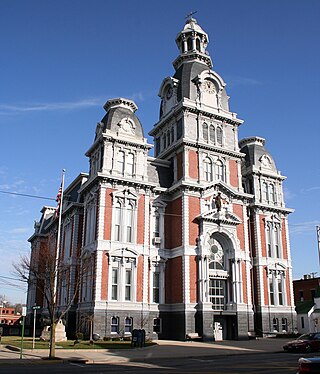Related Research Articles

Van Wert County is a county located in the U.S. state of Ohio. As of the 2020 census, the population was 28,931. Its county seat is Van Wert. The county was created in February 12, 1820 and later organized on March 18, 1837. It is named for Isaac Van Wart, one of the captors of John André in the American Revolutionary War.

U.S. Route 30 or U.S. Highway 30 (US 30) is an east–west main route in the system of the United States Numbered Highways, with the highway traveling across the northern tier of the country. With a length of 3,073 miles (4,946 km), it is the third longest U.S. highway, after US 20 and US 6. The western end of the highway is at US 101 in Astoria, Oregon; the eastern end is at Virginia Avenue, Absecon Boulevard, and Adriatic Avenue in Atlantic City, New Jersey. The "0" as the last digit in the number indicates that it is a coast-to-coast route and a major east-west route. Despite long stretches of parallel and concurrent Interstate Highways, it has not been decommissioned unlike other long haul routes such as US 66. It is also the only U.S. Highway that has always been coast-to-coast since the beginning of U.S. Route system.

The Interurban is a type of electric railway, with streetcar-like electric self-propelled rail cars which run within and between cities or towns. They were very prevalent in North America between 1900 and 1925 and were used primarily for passenger travel between cities and their surrounding suburban and rural communities. The concept spread to countries such as Japan, the Netherlands, Switzerland, Belgium, Italy and Poland. Interurban as a term encompassed the companies, their infrastructure, their cars that ran on the rails, and their service. In the United States, the early 1900s interurban was a valuable economic institution. Most roads between towns and many town streets were unpaved. Transportation and haulage was by horse-drawn carriages and carts. The interurban provided reliable transportation, particularly in winter weather, between the town and countryside. In 1915, 15,500 miles (24,900 km) of interurban railways were operating in the United States and, for a few years, interurban railways, including the numerous manufacturers of cars and equipment, were the fifth-largest industry in the country. By 1930, most interurbans in North America were gone with a few surviving into the 1950s.
Brentwood S. Tolan was an American architect. His most notable works include the National Historic Landmark-designated Allen County Courthouse in downtown Fort Wayne, Indiana, the Whitley County Courthouse in Columbia City, Indiana, the La Porte County Courthouse in La Porte, Indiana, as well as the now-demolished Old National Bank Building and Masonic Temple and Opera House in Fort Wayne.

Tower City Center is a large mixed-use facility in Downtown Cleveland, Ohio, on its Public Square. The facility is composed of a number of interconnected office buildings, including Terminal Tower, the Avenue shopping mall, Jack Cleveland Casino, Renaissance Cleveland Hotel, Chase Financial Plaza, and Tower City station, the main hub of Cleveland's four RTA Rapid Transit lines.

U.S. Route 224 (US 224) is a spur of US 24 that runs through the states of Indiana, Ohio and Pennsylvania. It currently runs for 289 miles (465 km) from US 24 in Huntington, Indiana, east to US 422 Business and Pennsylvania Route 18 (PA 18) in New Castle, Pennsylvania. It goes through the cities of Canfield, Ohio, Akron, Ohio, and Findlay, Ohio. In Northeast Ohio, US 224 is located a short distance north of the Western Reserve's southern boundary.

The LeVeque Tower is a 47-story skyscraper in Downtown Columbus, Ohio. At 555 feet 5 inches (169.29 m) it was the tallest building in the city from its completion in 1927 to 1974, and remains the second-tallest today.

State Route 309 is an east–west highway in central Ohio. Its western terminus is at its interchange with U.S. Route 30 (US 30) near Delphos, and its eastern terminus is at its interchange with US 30 in Mansfield. Its current route takes it through the cities of Lima, Kenton, Marion, Galion, and Ontario; as well as the villages of Elida and Caledonia.

WDOH is a commercial American radio station licensed to Delphos with a classic hits format. Its studios are located in Delphos and offices are located in Lima, Ohio with transmitter located in Delphos between Van Wert and Lima.
The Lima–Van Wert–Wapakoneta Combined Statistical Area (CSA) is made up of three counties in Northwest Ohio. The Lima Metropolitan Statistical Area and two Micropolitan Statistical Areas – Van Wert and Wapakoneta, are components of the CSA. As of the 2000 Census, the CSA had a population of 184,743.

State Route 697 is an east–west state highway in the western portion of Ohio, a U.S. state. The western terminus of State Route 697 is located at its junction with State Route 116 approximately 2 miles (3.2 km) southwest of Middle Point. The eastern terminus of this route is located on the northern fringe of downtown Delphos, following a nearly 0.25 miles (0.40 km) concurrency with State Route 66 at a signalized intersection that doubles as the southern terminus of State Route 190.

The historic Subway Terminal, now Metro 417, opened in 1925 at 417 South Hill Street near Pershing Square, in the core of Los Angeles as the second, main train station of the Pacific Electric Railway; it served passengers boarding trains for the west and north of Southern California through a mile-long shortcut under Bunker Hill popularly called the "Hollywood Subway," but officially known as the Belmont Tunnel. The station served alongside the Pacific Electric Building at 6th & Main, which opened in 1905 to serve lines to the south and east. The Subway Terminal was designed by Schultze and Weaver in an Italian Renaissance Revival style, and the station itself lay underground below offices of the upper floors, since repurposed into the Metro 417 luxury apartments. When the underground Red Line was built, the new Pershing Square station was cut north under Hill Street alongside the Terminal building, divided from the Subway’s east end by just a retaining wall. At its peak in the 20th century, the Subway Terminal served upwards of 20 million passengers a year.

U.S. Route 30 (US 30) is a United States Numbered Highway that runs from Astoria, Oregon, to Atlantic City, New Jersey. In the state of Ohio, it is a major, 245-mile-long (394 km), east–west highway that runs through the northern section of the state. Overall, the highway runs through rural areas dominated by farm fields or woodlands; some segments are urban in character in the Mansfield and Canton areas.

WERT is a radio station broadcasting adult standards featuring soft oldies from the 1940s through today. Licensed to Van Wert, Ohio, United States, the station serves Van Wert primarily but is considered part of the Lima market. The station is currently owned by First Family Broadcasting and broadcasts from its studios on the Lincoln Highway just east of Van Wert.

US Highway 127 (US 127) is a part of the United States Numbered Highway System that runs from Chattanooga, Tennessee, to the Lower Peninsula of Michigan. In Ohio, the highway runs 194.27 miles (312.65 km) from the Ohio River in Cincinnati to the Michigan state line north of West Unity. US 127 runs south to north in Ohio's westernmost counties along the border of Indiana. The highway is a main route connecting many small towns, including eight county seats. The highway was first designated in 1926. Its route ended in downtown Toledo before being realigned to its current route in 1930.

Thomas D. McLaughlin was an American architect in Lima, Ohio. His work included the design for Notre Dame College's Administration Building that was built in 1927 in a Tudor Revival architectural style, along with other styles.

Hays Hall was a residence hall at Washington & Jefferson College. The architectural work was performed by Frederick J. Osterling and it was named after President George P. Hays. Construction was completed in 1903 and the new "fireproof" building was opened to Washington & Jefferson Academy students. Rooms were arranged in a suite style, with communal bathrooms on each floor, and shower baths on the 5th floor. In 1912, the Academy closed and Hays Hall was used by Washington & Jefferson College students. At various times, Hays Hall housed the bookstore and a dining hall. By 1968, Hays Hall had deteriorated to the point where it no longer able to house students, but the bookstore remained. In 1982, the building was declared a fire hazard and closed for all uses. While various efforts sought to renovate or restore Hays Hall, including a push to have it named a historical landmark, Hays Hall was demolished in 1994.

The Marsh Foundation School is an alternative school in Van Wert, Ohio, United States. Housed in a complex of historic buildings along the former Lincoln Highway, the school and an associated children's home were founded to serve impoverished children throughout northwestern Ohio.

The Van Wert County Courthouse is a historic governmental building in downtown Van Wert, Ohio, United States. Located at 121 E. Main Street, the courthouse is a Second Empire structure built in 1876. It is Van Wert County's third courthouse: when the county was established, the village of Willshire was designated the county seat; Van Wert was made the seat in 1838, and a courthouse-and-jail complex was built in that community in the following year.
Vantage Career Center is a public vocational school located in Van Wert, Ohio. It serves school districts located in the counties of Allen, Mercer, Paulding, Putnam, and Van Wert. Classes are open to juniors and seniors in local high schools.
References
- ↑ Holdgreve, Bob. "Window to the Past: Interurban (traction line) comes to Delphos". Delphos Historical Society. Archived from the original on February 5, 2007. Retrieved April 24, 2007.
- 1 2 "Ohio Lincoln Highway Historic Byway: Downtown Van Wert, OH". National Scenic Byways Program. Archived from the original on October 10, 2007. Retrieved April 22, 2007.
Coordinates: 40°52′10″N84°34′54″W / 40.869358°N 84.581737°W